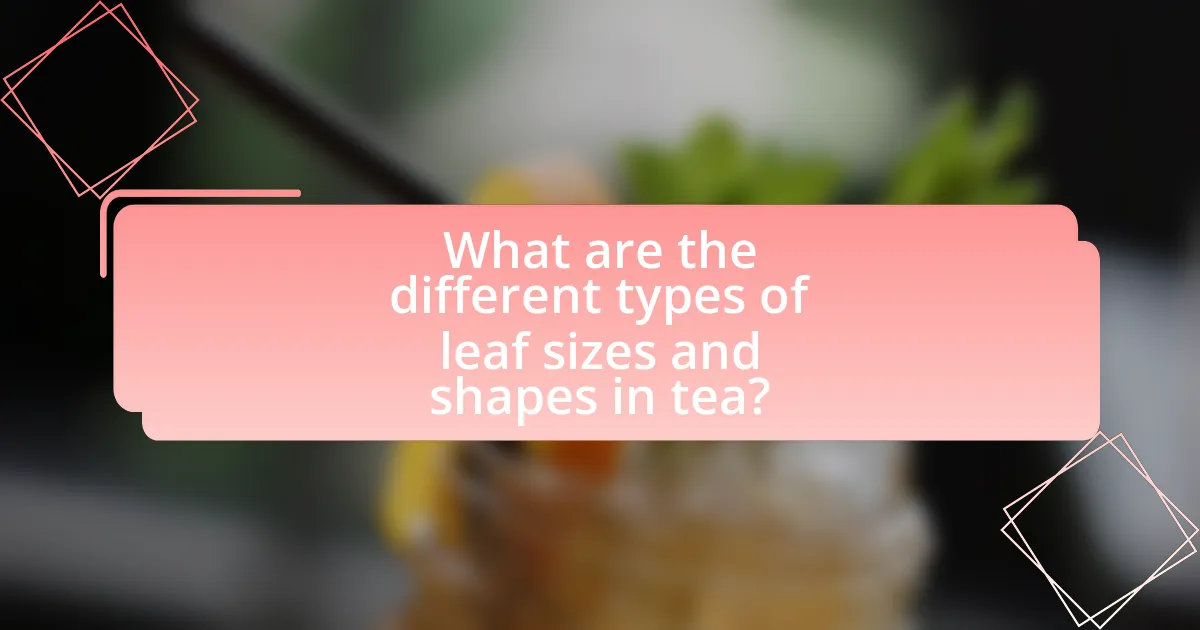The article examines the significant influence of leaf size and shape on tea grading, highlighting how these characteristics affect the quality, flavor, and appearance of tea products. It discusses the correlation between larger, whole leaves and higher quality teas, as well as the implications of smaller or broken leaves on flavor complexity and infusion rates. Additionally, the article explores the importance of uniformity, maturity, and specific leaf shapes in the grading process, alongside other factors such as aroma and color. The relationship between leaf morphology and processing methods is also addressed, emphasizing best practices for producers to optimize grading outcomes based on leaf characteristics.

What is the Influence of Leaf Size and Shape on Tea Grading?
Leaf size and shape significantly influence tea grading by affecting the quality, flavor, and appearance of the final product. Larger, whole leaves are often associated with higher quality teas, as they tend to retain more essential oils and flavors during processing. Conversely, smaller or broken leaves may indicate lower quality, as they can lead to a faster infusion and a less complex flavor profile. Research has shown that specific leaf shapes, such as those found in certain cultivars, can also impact the brewing characteristics and overall sensory experience of the tea, further influencing grading standards.
How do leaf size and shape affect the quality of tea?
Leaf size and shape significantly influence the quality of tea by affecting the extraction of flavors and compounds during brewing. Larger leaves tend to release flavors more slowly, resulting in a milder taste, while smaller, more finely shaped leaves release flavors quickly, leading to a stronger infusion. Research indicates that the surface area of the leaves plays a crucial role; for instance, a study published in the Journal of Agricultural and Food Chemistry found that smaller leaf particles enhance the extraction of polyphenols, which are vital for the tea’s flavor and health benefits. Therefore, the characteristics of leaf size and shape directly correlate with the overall quality and flavor profile of the tea produced.
What specific characteristics of leaf size are important in tea grading?
The specific characteristics of leaf size important in tea grading include the uniformity, maturity, and overall dimensions of the leaves. Uniformity in size indicates consistent quality and processing, while mature leaves typically yield better flavor and aroma, which are critical for high-grade teas. Additionally, the dimensions of the leaves, such as length and width, can affect the brewing characteristics and extraction rates, influencing the final taste profile. Research has shown that teas made from larger, more mature leaves often command higher prices due to their superior quality and flavor attributes.
How does leaf shape contribute to the overall grading process?
Leaf shape significantly influences the overall grading process in tea by affecting the visual appeal, aroma release, and brewing characteristics of the tea. Graders assess leaf shape to determine quality, as uniform and well-defined shapes indicate careful processing and higher quality. For instance, flat and whole leaves are often associated with premium teas, while broken or uneven shapes may suggest lower quality. Research indicates that the shape of tea leaves can impact the infusion rate and flavor profile, with certain shapes allowing for better extraction of essential oils and flavors during brewing. This correlation between leaf shape and quality attributes is critical in the grading process, as it helps establish market value and consumer preference.
Why is tea grading significant in the tea industry?
Tea grading is significant in the tea industry because it determines the quality and market value of tea products. The grading process assesses factors such as leaf size, shape, and appearance, which directly influence consumer preferences and pricing. For instance, higher grades typically consist of whole, unbroken leaves, which are associated with superior flavor and aroma, leading to higher prices in the market. Additionally, standardized grading systems, such as those established by the Tea Board of India, provide a framework for consistency and transparency, enabling buyers and sellers to make informed decisions based on quality. This structured approach not only enhances trade efficiency but also helps maintain the reputation of tea brands globally.
What role does grading play in determining tea pricing?
Grading plays a crucial role in determining tea pricing by categorizing tea based on quality attributes such as leaf size, shape, and appearance. Higher grades, which typically consist of whole leaves and exhibit superior characteristics, command higher prices due to their perceived quality and flavor profile. For instance, teas graded as “FTGFOP” (Finest Tippy Golden Flowery Orange Pekoe) are often priced significantly higher than lower grades like “BOP” (Broken Orange Pekoe) because they represent a more refined product with better taste and aroma. This grading system is widely recognized in the tea industry, influencing market demand and consumer preferences, thereby directly impacting pricing structures.
How does grading impact consumer perception of tea quality?
Grading significantly impacts consumer perception of tea quality by establishing a standardized measure of quality that influences purchasing decisions. Consumers often associate higher grades with superior flavor, aroma, and overall experience, leading them to prefer higher-graded teas over lower ones. Research indicates that consumers are willing to pay up to 30% more for teas that are graded higher, reflecting their belief in the correlation between grading and quality. This perception is reinforced by marketing practices that emphasize grading as a key indicator of tea excellence, further shaping consumer preferences and choices in the marketplace.

What are the different types of leaf sizes and shapes in tea?
Tea leaves exhibit a variety of sizes and shapes, which can be categorized primarily into three types: whole leaves, broken leaves, and fannings. Whole leaves are typically larger and retain their original shape, contributing to higher quality grades. Broken leaves are smaller fragments of whole leaves, often resulting from processing and handling, and are associated with mid-range quality. Fannings are even smaller particles, usually used in tea bags, and represent lower quality. The size and shape of tea leaves directly influence the brewing characteristics and flavor profile, with whole leaves generally providing a more nuanced taste due to their slower infusion rate.
What are the common leaf sizes found in various tea types?
Common leaf sizes in various tea types vary significantly. For example, green tea typically features smaller, tender leaves, often measuring around 1 to 3 centimeters in length. In contrast, black tea leaves are generally larger, ranging from 2 to 5 centimeters, and can be twisted or rolled. Oolong tea leaves fall in between, usually measuring 2 to 4 centimeters, and are often semi-oxidized, affecting their size and shape. White tea, made from young buds and leaves, tends to have the smallest leaves, often less than 2 centimeters. These size variations are crucial for tea grading, as they influence the flavor profile and quality of the tea.
How does the size of tea leaves vary among green, black, and oolong teas?
The size of tea leaves varies significantly among green, black, and oolong teas. Green tea leaves are typically smaller and more delicate, often resembling needle-like shapes, while black tea leaves are generally larger and can be twisted or rolled, resulting in a broader surface area. Oolong tea leaves fall in between, being larger than green tea leaves but often smaller than black tea leaves, and they may be partially rolled or twisted. This variation in size is influenced by the processing methods and the specific tea cultivar used, which affects the final grading and quality of the tea.
What are the implications of leaf size on brewing and flavor?
Leaf size significantly impacts brewing and flavor in tea. Larger leaves tend to release flavors more slowly, resulting in a milder taste, while smaller leaves release flavors quickly, leading to a more robust and intense brew. This is due to the increased surface area of smaller leaves, which allows for faster extraction of essential oils and compounds during the brewing process. Studies have shown that teas made from smaller leaves often have higher concentrations of catechins and other flavor compounds, enhancing the overall flavor profile.
What shapes do tea leaves typically exhibit?
Tea leaves typically exhibit shapes that are flat, elongated, and sometimes curled. The flat shape allows for optimal exposure to sunlight during growth, while the elongated form aids in the efficient collection of moisture. Additionally, some tea leaves may curl during processing, which can enhance flavor concentration. These shapes are significant in tea grading, as they influence the quality and characteristics of the final product. For example, high-quality teas often feature whole, unbroken leaves, which are indicative of careful harvesting and processing methods.
How do different leaf shapes influence the extraction of flavors during brewing?
Different leaf shapes significantly influence the extraction of flavors during brewing by affecting the surface area and the rate of infusion. For instance, broader leaves typically provide a larger surface area, allowing for quicker extraction of soluble compounds, resulting in a more robust flavor profile. Conversely, smaller or more finely shaped leaves may release flavors more slowly, leading to a subtler taste. Research indicates that the shape and size of tea leaves can alter the release of catechins, amino acids, and aromatic compounds, which are crucial for flavor development. Studies have shown that specific shapes, such as needle-like leaves, can enhance the extraction of certain flavor notes due to their unique structural properties, thereby impacting the overall sensory experience of the brewed tea.
What are the visual indicators of leaf shape that affect grading?
The visual indicators of leaf shape that affect grading include leaf length, width, and overall contour. Leaf length and width are critical as they determine the size category of the tea leaves, which influences their market value; for instance, longer and broader leaves are often associated with higher quality. Additionally, the contour, which refers to the edges and shape of the leaf, can indicate the variety and maturity of the tea plant, impacting grading decisions. Research has shown that specific shapes, such as whole leaves versus broken fragments, significantly affect the perceived quality and grading of tea, as whole leaves tend to retain more flavor and aroma compounds.

How do leaf size and shape interact with other grading factors?
Leaf size and shape significantly interact with other grading factors in tea, influencing overall quality assessments. Larger leaves often indicate a more mature plant, which can correlate with higher flavor profiles, while smaller leaves may suggest younger plants with different taste characteristics. Additionally, the shape of the leaves, whether whole or broken, affects the infusion process; whole leaves tend to release flavors more slowly, impacting the brewing time and resulting taste. Research indicates that uniformity in leaf size and shape contributes to consistent flavor extraction, which is a critical grading criterion in the tea industry. Thus, the interaction between leaf size, shape, and other grading factors like aroma and color is essential for determining the final quality of tea products.
What other factors are considered in tea grading alongside leaf size and shape?
In tea grading, factors considered alongside leaf size and shape include color, aroma, and the presence of tips or buds. Color indicates the freshness and quality of the tea leaves, with vibrant green or golden hues often signifying higher quality. Aroma contributes to the overall sensory experience, with distinct fragrances being associated with specific tea types. The presence of tips or buds, which are young leaves, is also a critical factor, as they typically enhance the flavor profile and are often sought after in premium teas. These elements collectively influence the overall grading and market value of the tea.
How do aroma and color complement the assessment of leaf size and shape?
Aroma and color enhance the assessment of leaf size and shape by providing additional sensory information that influences the overall quality evaluation of tea. The aroma, derived from volatile compounds released by the leaves, can indicate freshness and the presence of desirable flavor profiles, which are often associated with specific leaf sizes and shapes. For instance, larger, whole leaves may retain more essential oils, resulting in a more robust aroma compared to smaller, broken leaves. Similarly, color serves as a visual cue; vibrant green leaves typically suggest higher quality and optimal processing conditions, while dull or discolored leaves may indicate age or poor handling. Research has shown that both aroma and color are critical factors in tea grading, as they correlate with the chemical composition and sensory attributes of the final brew, thus reinforcing the importance of leaf size and shape in determining tea quality.
What is the relationship between leaf size, shape, and the tea’s processing method?
Leaf size and shape significantly influence the processing method of tea, as these characteristics determine how the leaves react during withering, rolling, and oxidation. Larger leaves, for instance, are often used in high-quality teas and require gentler processing to preserve their integrity, while smaller leaves may be processed more aggressively, leading to different flavor profiles. The shape of the leaves also affects how they release essential oils and flavors during steeping; flat leaves tend to unfurl more easily, enhancing extraction, whereas tightly rolled leaves may require longer infusion times. Studies have shown that the processing method, such as pan-firing or steaming, is tailored to the specific leaf characteristics to optimize flavor and aroma, confirming the direct relationship between leaf morphology and processing techniques.
How can producers optimize leaf size and shape for better grading outcomes?
Producers can optimize leaf size and shape for better grading outcomes by implementing targeted cultivation practices such as selective breeding and precise environmental control. Selective breeding allows producers to choose plants that naturally produce leaves with desirable characteristics, such as uniform size and shape, which are preferred in grading standards. Additionally, controlling environmental factors like light, temperature, and humidity can influence leaf morphology, leading to optimal leaf development. Research indicates that specific light conditions can enhance leaf expansion and shape, resulting in higher quality tea leaves that meet grading criteria.
What cultivation practices can enhance desirable leaf characteristics?
Cultivation practices that can enhance desirable leaf characteristics include proper pruning, optimal irrigation, and soil management. Pruning encourages new growth and can improve leaf size and shape, which are critical for tea grading. Optimal irrigation ensures that plants receive adequate water, promoting healthy leaf development. Soil management, including the use of organic fertilizers, enhances nutrient availability, leading to better leaf quality. Research indicates that these practices can significantly influence the morphological traits of tea leaves, thereby affecting their grading and market value.
How does harvesting timing affect leaf size and shape?
Harvesting timing significantly influences leaf size and shape in tea plants. Early harvesting typically results in smaller, more tender leaves, while later harvesting can yield larger, more mature leaves with different shapes due to extended growth periods. Research indicates that the physiological changes in tea plants, driven by environmental factors and growth stages, directly affect leaf morphology. For instance, a study published in the Journal of Agricultural Science by Zhang et al. (2020) demonstrated that leaves harvested at optimal maturity stages exhibited a balance of size and shape conducive to higher quality tea production. This correlation underscores the importance of precise harvesting timing in achieving desirable leaf characteristics for tea grading.
What best practices should tea producers follow for grading based on leaf characteristics?
Tea producers should implement a systematic grading process based on leaf characteristics, focusing on size, shape, color, and overall quality. This involves categorizing leaves into distinct grades, such as whole leaves, broken leaves, and fannings, which directly correlate with the tea’s flavor profile and market value.
Producers should also utilize visual inspection and standardized measurement tools to assess leaf size and shape accurately, ensuring consistency in grading. For instance, whole leaves typically yield higher quality tea, while smaller broken leaves may produce a different flavor profile. Additionally, maintaining proper drying and storage conditions preserves leaf integrity, which is crucial for accurate grading.
Research indicates that uniformity in leaf size and shape can enhance the brewing process, leading to a more desirable flavor and aroma, thus reinforcing the importance of these grading practices in the tea industry.


